The biggest class action lawsuit payout per person in history was shaped by several key factors. For example, the BP Gulf Oil Spill offered an average of $200,000 per claimant, driven by its high settlement amount and relatively small pool of participants. This case highlights how settlement size, claimant numbers, and the severity of damages determine such record-breaking compensation.
At Sparrow, we specialize in helping claimants understand and maximize their share in class action lawsuits. Whether navigating cases involving large-scale environmental disasters like the Chemtool fire lawsuit or deceptive business practices like the Market America lawsuit, we ensure individuals have the resources to assess their eligibility and file claims effectively.
Leveraging our expertise in class action settlements, we’ve crafted this guide to break down the factors influencing individual payouts, explore examples of record-setting cases, and help you set realistic expectations.
Let’s get started!
What Determines Individual Payouts in Class Action Lawsuits?
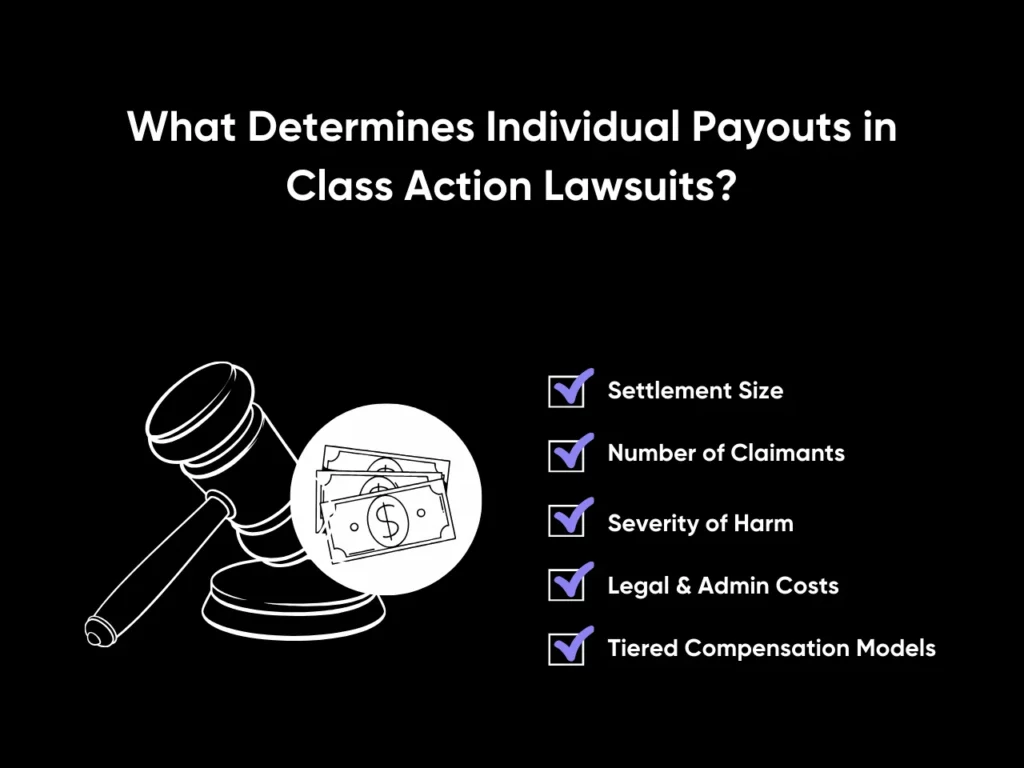
Payouts depend on settlement size, claimant numbers, and severity of harm. The biggest class action lawsuit payout per person may be the $200,000 average in the BP Gulf Oil Spill, influenced by catastrophic damages and a smaller claimant pool.
Other cases, such as the Black Saturday Bushfires or the Volkswagen Emissions Scandal, highlight how smaller groups or severe damages can result in significant compensation per individual. However, not all class actions lead to such high payouts, as settlement funds are often diluted among large groups of claimants.
Here are the factors affecting the average payout per person:
Settlement Size
The total settlement amount is the foundation for calculating payouts. More significant settlements offer the potential for higher compensation, but this is heavily influenced by other factors, such as the size of the claimant pool and the complexity of the case.
Even with a substantial settlement, claimants may receive varying amounts depending on how funds are distributed. Settlements must also account for legal fees, administrative costs, and any conditions tied to the payout process.
Number of Claimants
The number of participants in a class action lawsuit directly affects individual payouts. When a settlement is distributed among a large group of claimants, the per-person amount decreases. Conversely, smaller groups often lead to higher compensation per claimant.
This dynamic underscores the importance of understanding the claimant pool size when assessing potential payouts. Larger groups may also require more complex administrative processes, which can delay distributions and reduce available funds.
Severity of Harm
The severity of harm is a crucial factor in determining payouts. Cases involving extreme financial losses, personal injuries, or environmental damage typically prioritize higher compensation for those most affected. Courts and settlement administrators often establish criteria to assess harm, ensuring claimants with significant losses or injuries receive larger portions of the settlement. This tiered approach helps balance fairness and equitable compensation.
Legal and Administrative Costs
Settlements often allocate a percentage of funds to cover attorneys’ fees and administrative expenses. These costs can consume 20-40% of the settlement amount, reducing the total available for claimants. Legal complexities, prolonged litigation, or high administrative demands can increase these costs.
Tiered Compensation Models
Many class actions use tiered compensation models to allocate funds based on the level of harm or losses experienced by claimants. This approach ensures that individuals with documented or severe damages receive higher payouts.
Tiered models often rely on evidence provided by claimants, such as medical costs, medical bills, or proof of financial losses. While these systems aim for fairness, they can create variability in payouts, with some claimants receiving significantly more than others.
Examples of Record-Setting Payouts Per Person
The largest class action settlements vary significantly based on the total settlement amount, the number of claimants, and the nature of the damages incurred. Below is a detailed analysis of a number of cases and how individual payouts were determined:
BP Deepwater Horizon Oil Spill (2010)
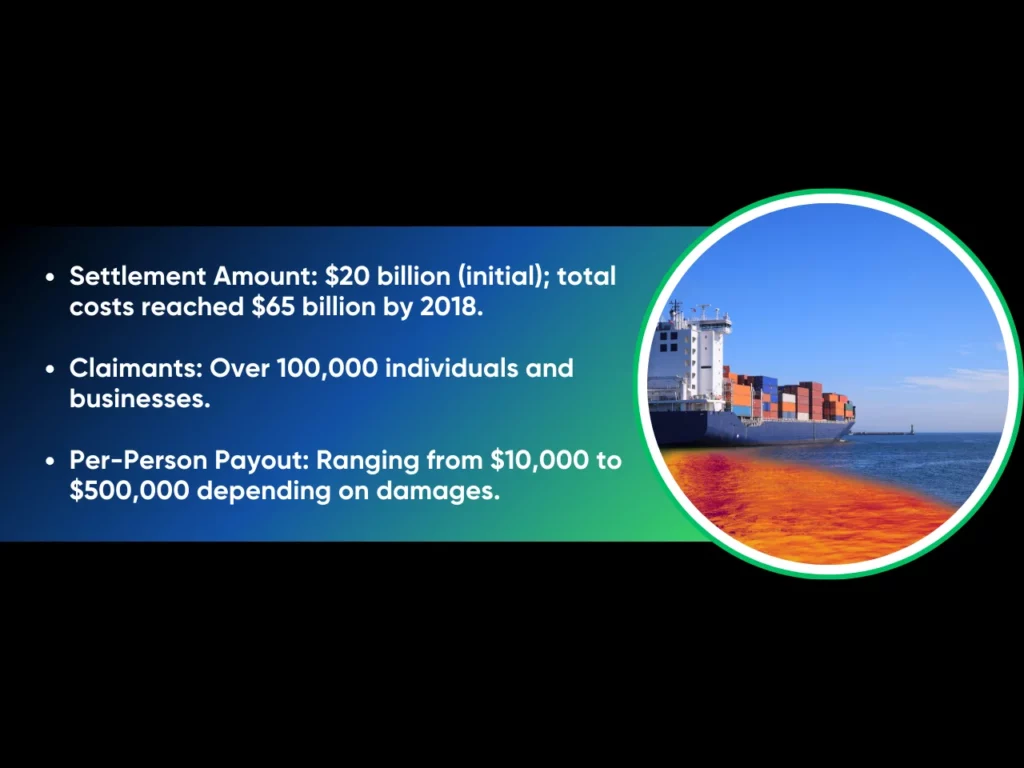
- Settlement Amount: Approximately $20 billion (initial major settlement); total costs reached an estimated $65 billion by 2018.
- Claimants: Over 100,000 individuals and businesses.
- Per-Person Payout: Varied widely; some businesses received substantial sums, while many individuals received smaller amounts but might have ranged between $10,000 and $500,000, depending on the extent of damages and losses.
The Deepwater Horizon oil spill, one of the largest environmental disasters in U.S. history, caused 11 fatalities and devastating ecological and economic damage across the Gulf Coast. By January 2018, BP’s total costs for cleanup, legal fees, settlements, and penalties reached approximately $65 billion, following an additional $1.7 billion charge for the outstanding number of claims under the Court Supervised Settlement Program (CSSP), which addressed nearly 400,000 cases.
BP’s liabilities included a landmark $19 billion settlement in 2015 for federal and state claims, as well as significant allocations for environmental restoration and Clean Water Act penalties. The unpredictable nature of claims, particularly those involving economic losses and property damage, drove costs higher over time. The disaster’s magnitude required substantial long-term efforts to address its environmental and economic impacts, and quite possibly, it has the biggest class action lawsuit payout per person in history.
Pigford II Settlement (2010)
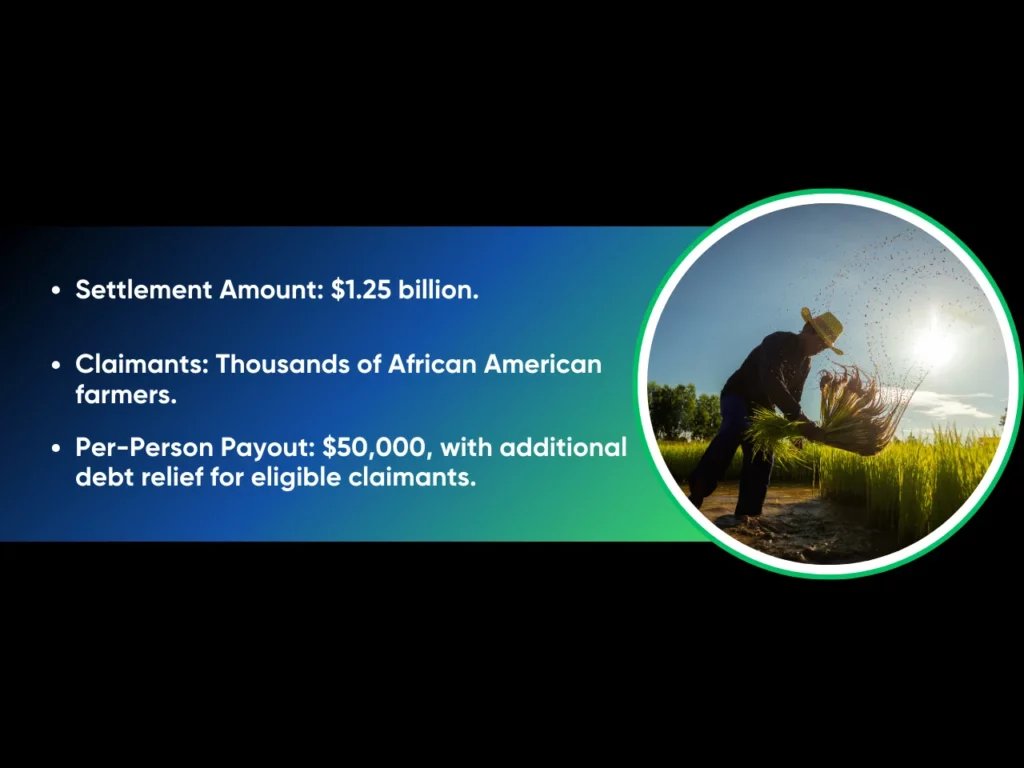
- Settlement Amount: $1.25 billion.
- Claimants: Thousands of African American farmers.
- Per-Person Payout: $50,000, with additional debt relief for eligible claimants.
The Pigford II Settlement resolved claims of racial discrimination brought by African American farmers against the US Department of Agriculture. Supported by the US Department of Justice and the federal government, the settlement aimed to address decades of systemic discrimination in USDA loan programs. Eligible farmers received financial compensation of $50,000 each, alongside debt relief for those who could demonstrate significant harm caused by discriminatory practices.
Volkswagen Emissions Scandal (2016)
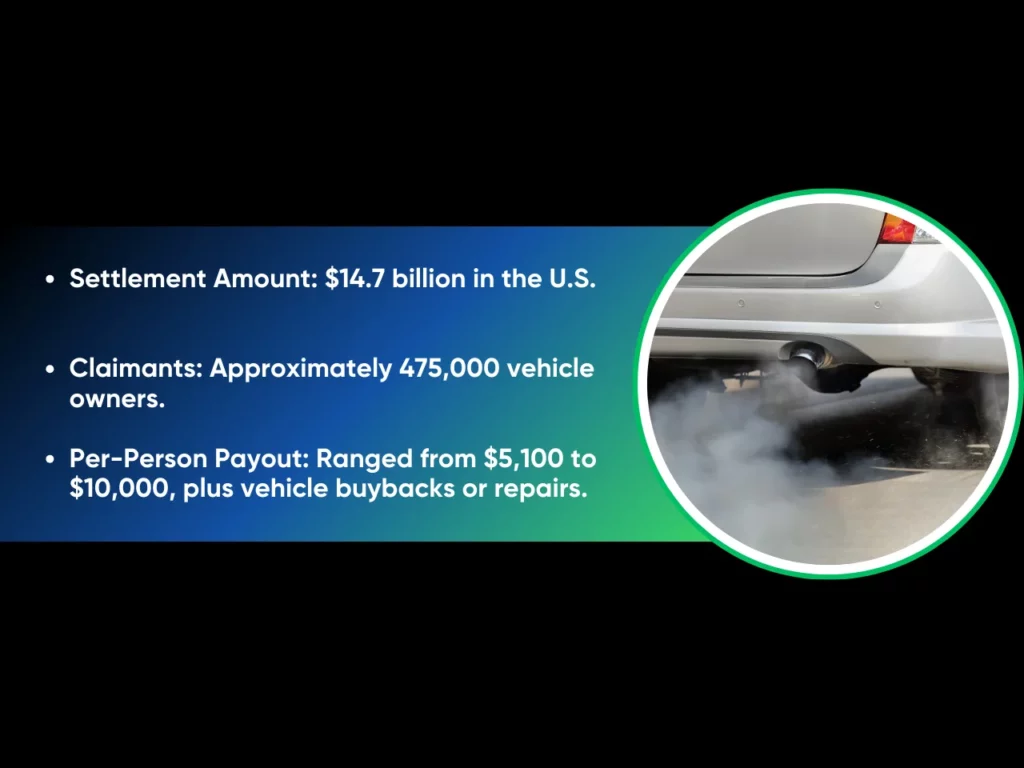
- Settlement Amount: $14.7 billion in the U.S.
- Claimants: Approximately 475,000 vehicle owners.
- Per-Person Payout: Ranged from $5,100 to $10,000, plus vehicle buybacks or repairs.
While paling in comparison with the biggest class action lawsuit payout per person mentioned in the preceding section, the Volkswagen’s emission tests scandal, commonly referred to as “Dieselgate,” still resulted in one of the largest settlements in the class action history of the United States. Claimants were offered vehicle buybacks or repairs for their diesel cars along with cash compensation. The payout amounts were influenced by factors such as the vehicle’s age, mileage, and market value. This combination of cash payments and structural remedies ensured that affected diesel car owners were adequately compensated while addressing environmental concerns.
Black Saturday Bushfires Australia (2009)
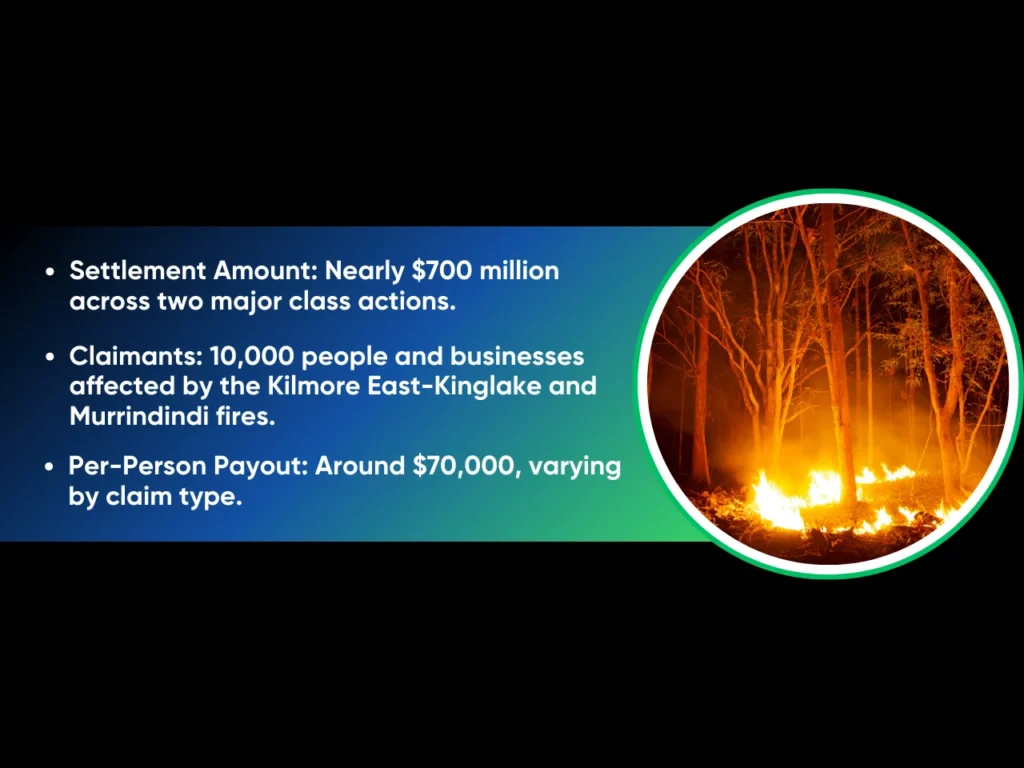
- Settlement Amount: Nearly $700 million across two major class actions.
- Claimants: Approximately 10,000 individuals and businesses were affected by the Kilmore East-Kinglake and Murrindindi fires.
- Per-Person Payout: Approximately $70,000, varying based on individual claims for injuries, economic losses, and property damage.
The Black Saturday bushfires, one of Australia’s deadliest natural disasters, resulted in 173 deaths and widespread destruction across Victoria. The Supreme Court of Victoria oversaw settlements for two significant class actions: the Kilmore East-Kinglake case, settled for $494.67 million in 2014, and the Murrindindi case, settled for $300 million in 2015. After litigation and administration costs, $698.5 million was distributed to claimants.
Compensation covered injuries, dependencies, economic losses, and property damage. Claims required individual assessments, with payouts reflecting the extent of personal and financial losses. Justice Forrest emphasized the importance of the class action litigation process in providing access to justice for thousands of affected individuals, ensuring compensation that might otherwise have been unattainable. The settlements marked the conclusion of complex legal proceedings nearly eight years after the fires.
Juul Labs Settlement (2024)
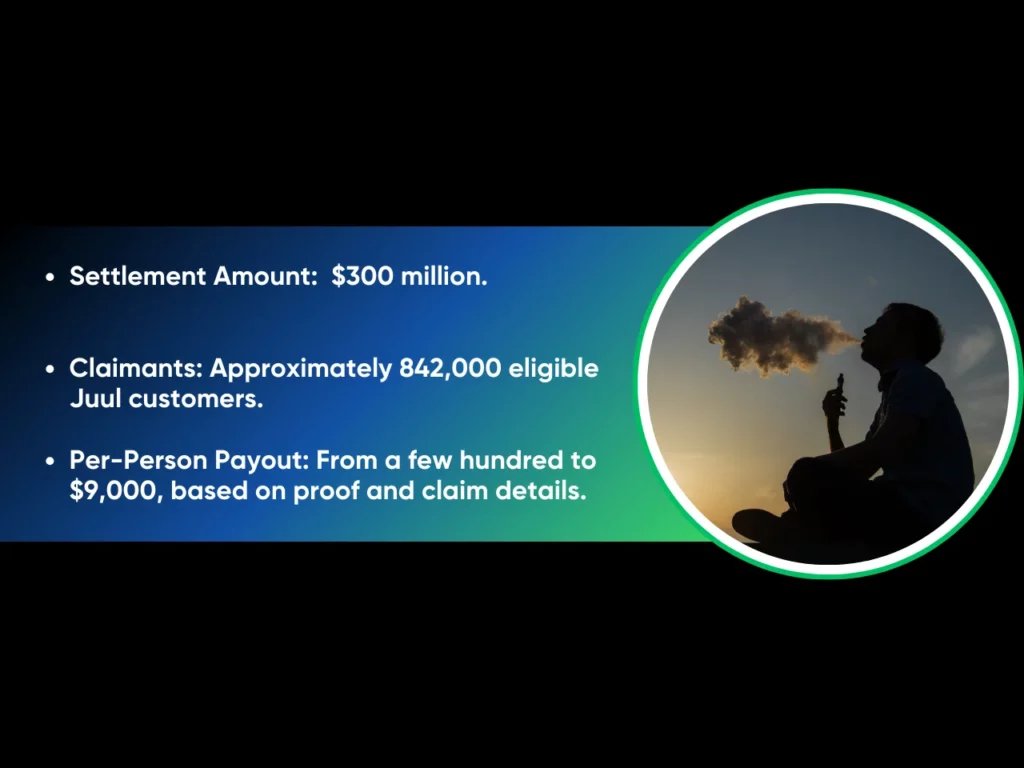
- Settlement Amount: $300 million.
- Claimants: Approximately 842,000 eligible Juul customers.
- Per-Person Payout: Ranged from a few hundred dollars to $9,000, depending on proof of purchase and claim details.
The newest entrant in the “biggest class action lawsuit payout per person” criteria, this global settlement resolved claims that Juul Labs and Altria misled consumers about the addictiveness and safety of Juul products and unlawfully marketed to minors. Approved in two parts—Juul’s 2022 settlement and Altria’s final approval earlier this year—payouts began in October 2024. Eligible class members, verified through receipts and other documentation, are sharing deposits within the stated range, with larger payouts awarded to those providing substantial proof of purchase.
Special Mention: Tobacco Master Settlement Agreement (1998)
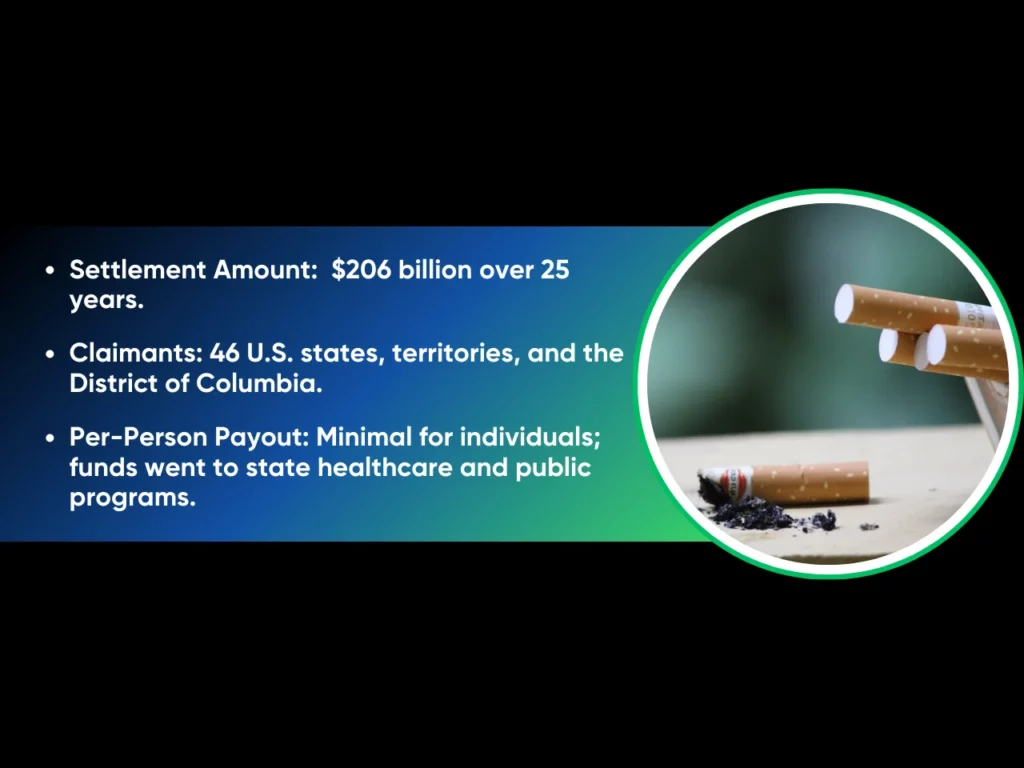
- Settlement Amount: $206 billion over 25 years.
- Claimants: 46 U.S. states, territories, and the District of Columbia.
- Per-Person Payout: Minimal to none for individuals; funds were directed toward state healthcare systems and public health programs.
The Tobacco Master Settlement Agreement remains the largest settlement in U.S. history. Philip Morris, RJ Reynolds, and other tobacco companies agreed to pay $206 billion after facing claims from the attorneys general of 46 US states for misleading the public about the dangers of smoking. Unlike typical class actions, individual smokers did not receive compensation. Instead, the funds were allocated to local governments to support public health campaigns, smoking cessation programs, and general healthcare improvements.
While the settlement focused on systemic reform rather than individual payouts, it played a pivotal role in reducing smoking rates across the U.S. and creating a foundation for modern public health measures. Its long-term impact continues to affect the tobacco industry today.
Why Some Class Actions Yield Larger Payouts
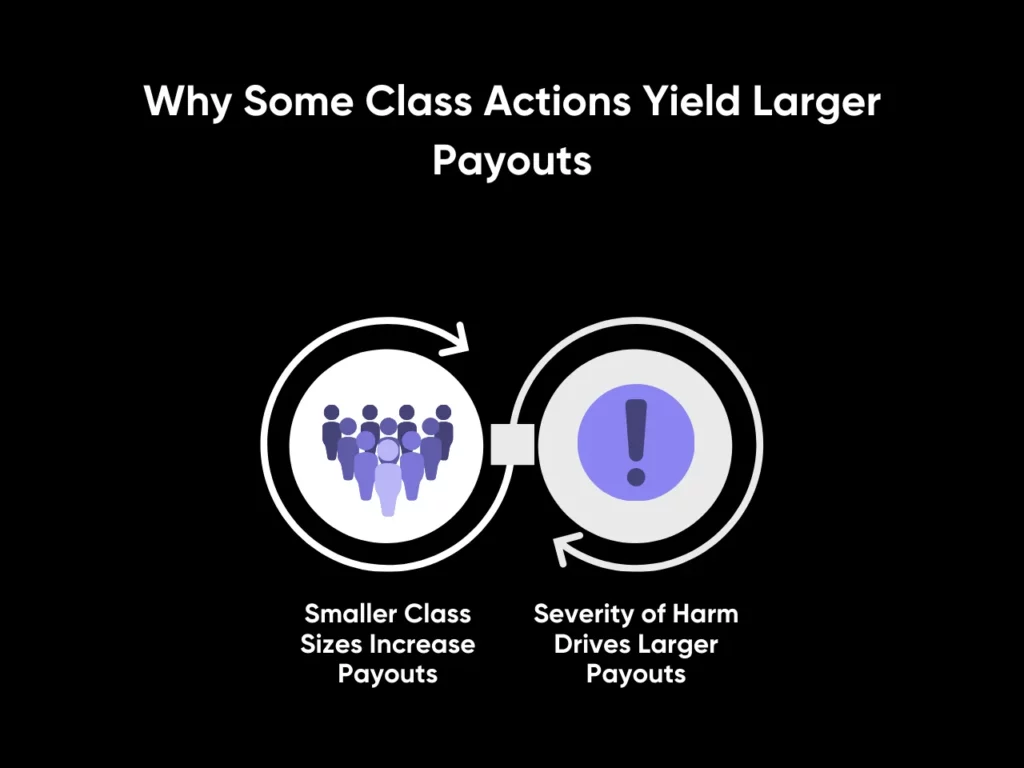
Class actions that deliver higher per-person payouts often share specific characteristics: smaller class sizes and strong cases involving severe harm or financial losses. These factors play a critical role in determining how settlement funds are distributed.
Smaller Class Sizes Increase Payouts
When a class action involves fewer claimants, the settlement funds are divided among a smaller group, leading to higher individual compensation. Smaller class sizes often occur in cases with localized harm, such as environmental disasters or narrowly defined eligibility criteria. With fewer claimants, administrative costs and legal fees consume a smaller proportion of the total settlement, leaving more funds available for direct payouts.
For example, environmental cases affecting a single region or financial fraud cases targeting a specific group of institutional investors often involve limited claimant pools. This smaller scope ensures that participants receive more substantial compensation compared to large-scale class actions with millions of participants.
The fewer the claimants, the higher the share of settlement funds available per person.
Severity of Harm Drives Larger Payouts
Severe physical injuries, health impacts, or financial devastation often lead to higher payouts in class action settlements. Courts and administrators prioritize those who experienced the most significant harm, ensuring compensation reflects the scale of their losses.
For example, in Cobell v. Salazar (2010), Native American claimants affected by land trust accounts mismanagement received an average of $1,000, with larger payouts allocated to those with documented financial losses. This tiered approach ensured fairness while addressing systemic harm.
Severe harm, whether physical or financial, often results in prioritization for higher compensation in class action settlements. A common denominator among the listed cases that are infamous for having the biggest class action lawsuit payout per person is the sheer magnitude of the blunder that the companies committed, which affected thousands of people.
Key Takeaway
The biggest class action lawsuit payout per person in history proves that sometimes, less is more—fewer claimants and severe damages can lead to truly historic compensation. These cases set the gold standard for justice delivered on a personal scale.
But what makes these payouts possible? Factors like settlement size, class size, and the complexity of harm can make or break your potential share. Understanding how these dynamics work is key to evaluating your claim.
Curious about your rights in major class actions? Sparrow is here to guide you through every step of filing a class action lawsuit and ensuring you claim your fair share. Explore the Sparrow blog for more insights on articles relating to the biggest class action lawsuit payout per person in history.


